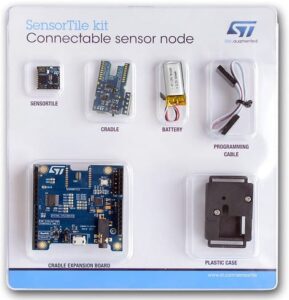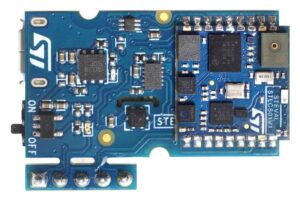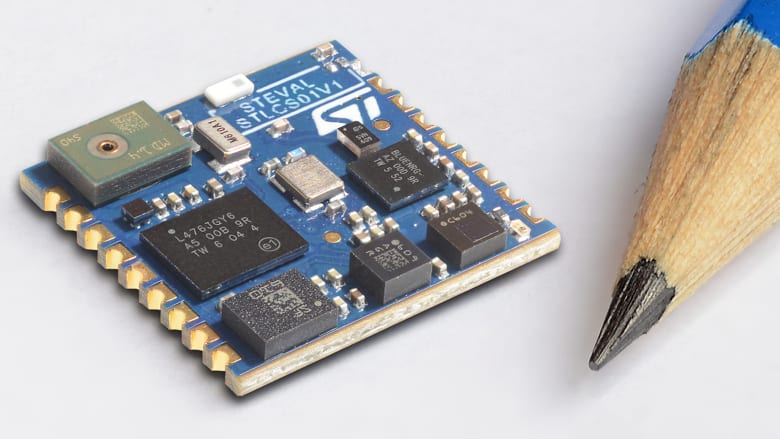One of the darlings of the ST Developers Conference that took place last October was SensorTile, the world’s densest sensor board. At 13.5 mm x 13.5 mm, it includes two 3D accelerometers, a 3D gyroscope, 3D magnetometer, pressure sensor, barometer, digital MEMS microphone, microcontroller (MCU) and Bluetooth Low Energy. ST announces today general availability of the SensorTile’s (STEVAL-STLKT01V) development kit for only US$89. Anyone can purchase it directly using ST’s website or through one of the company’s distributors.
SensorTile : All Things to All Projects

The reason SensorTile is so popular is because it’s a unique all-in-one package. Out of the box, research and development teams can use the small board in the STEVAL-STLKT01V kit to develop new products. ST provides documentation to enable them to modify the design and adapt it to shrink the final product according to their needs. For instance, Valencell was able to fit SensorTile in its small biometric solutions to offer pre-packaged designs to an industry in dire need of simplicity, efficiency, and accuracy.
However, within the kit, SensorTile also comes packaged with a cradle board (STLCR01V1), a battery, a plastic case, and a cradle expansion board (STLCX01V1). These tools can power the small board so even startups or lone engineers can start developing solutions immediately. Hence, SensorTile becomes a great value proposition because it becomes possible to start a project with little initial investment.
Furthermore, to make the package even more flexible, it is possible to either solder SensorTile onto the cradle or just plug it, depending on the type of application desired. For instance, teams searching for the best set of sensors can program different boards and swap them instantly. However, those that desire to test their portable solution in the field could very easily solder the SensorTile to increase its robustness.
The ST Advantage Concentrated

SensorTile is unique to ST because it draws from the company’s experience and mastery of sensors and mobile platforms. For instance, the board includes the LSM6DSM chip, which is the same low-power six-axis 3D gyroscope with 3D accelerometer that drones use. Similarly, the pressure sensor (LPS22HB) belongs to the same family of components found in devices aimed at athletes and ultra-precise tools, like the PIQ. Finally, ST chose a 3D magnetometer that also includes a 3D accelerometer (LSM303AGR). This allows developers to turn off the gyroscope or the magnetometer, and still benefit from an accelerometer, allowing them to reduce power consumption while retaining advanced functionalities.
All these chips converge towards the STM32L4, an ultra-low-power Cortex-M4 MCU with a dedicated conversion interface for the audio signal. Hence, reading the data captured by the digital MEMS microphone (MP34DT04) has virtually no impact on the system’s resources, as everything is hardware-accelerated. Hence, a smart speaker with ASR-optimized beamforming (Automatic Speech Recognition) is highly efficient when using SensorTile.
ST’s desire for the ultimate power-to-performance ratio is also reflected by a BlueNRG module that has been coupled with a single chip optimized balun. As we’ve recently explained, choosing the right balun can be quite tricky, but the system depends on it. ST offers its expertise and products to enhance all aspects of the RF design, ensuring that SensorTile’s Bluetooth solution remains powerful while consuming very little power.
Small Details, a World of Difference
As a matter of fact, even the type of RF module that made it in SensorTile was the result of great care and deliberation. ST chose to include a BlueNRG-MS (Master/Slave) component, so SensorTile’s wireless communication system can be the master of up to seven slaves or the slave of a master, which greatly simplifies the implementation of stack configurations. Adding peripherals, boards, and sensors that include less flexible Bluetooth modules is no longer a chore because SensorTile adapts itself to the engineers’ current set of components and designs. On top of it all, ST’s module is already FCC-certified, which means that any design that replicate its configuration is very likely to be FCC compliant.
This is only one of the many details that make SensorTile special. However, when all is said and done, the craftsmanship that went into this development platform is only truly understood when one plugs a USB cable in the cradle to power the system. Out of the box, the demo firmware can interact with a mobile device to help anyone experience the kit’s capabilities. Furthermore, SensorTile’s integration with the STM32 Open Development Environment means developers can start in minutes. Open libraries, source codes, and application examples make it intuitive to take advantage of the board’s power and precision. One can easily become acquainted with SensorTile, thanks to its Quick Start Guide and the unboxing video below. At that point, the immense technologies that went into this astonishingly small board fade into the background, so creativity and innovation can take center stage.
To learn more about SensorTile, please visit its product page.
